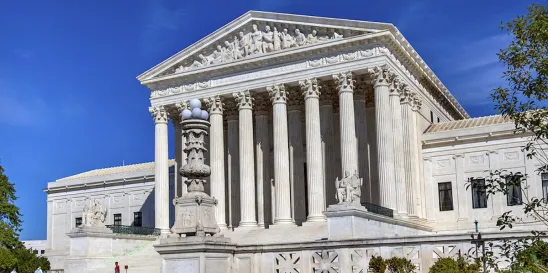The U.S. Supreme Court emerged from its January conference issuing orders in which it agreed to consider four major issues: 1) the extent of states’ authority to prosecute crimes committed in Indian country, 2) the lawfulness of affirmative action in college admissions, 3) federal district courts’ jurisdiction to hear constitutional challenges to administrative agencies, and 4) the scope of federal regulatory authority over wetlands under the Clean Water Act.
The first of these issues (regarding crimes in Indian country) will be considered during the Court’s April 2022 argument session, while the other three will likely be put off until the Court’s next term, which begins in October.
The nationwide significance of all four of these issues is underscored by the several cert-stage amicus briefs filed in each of the cases. While affirmative action will undoubtedly capture the most attention, the other issues will be of widespread interest as well – especially among prosecutors and criminal defense attorneys in states with Indian reservations, administrative-law litigators, landowners, and environmental groups.
States’ Authority to Prosecute Crimes Committed on Indian Reservations
In Oklahoma v. Castro-Huerta, the Court will address when states may prosecute non-Indians for crimes committed in Indian country, which comprises Indian reservations as well as other Indian communities. The dispute in this case specifically concerns crimes committed in Indian country by non-Indians against Indians. Oklahoma asserts that both the federal government and states may prosecute such crimes, while the respondent and several Indian tribes as amici take the position that the answer is settled law: Citing the 1959 case Williams v. Lee, they contend that the Supreme Court has long recognized that states lack authority to prosecute crimes committed by non-Indians against Indians in Indian country.
This issue – which will require the Court to consider its earlier decisions and parse the language of the 1817 General Crimes Act – received renewed attention with the Court’s 2020 decision in McGirt v. Oklahoma, which held that a large area encompassing nearly 2 million Oklahomans qualifies as Indian country. Oklahoma has responded to McGirt by filing multiple cert. petitions asking the Court to consider overruling its decision, but the Court has thus far declined to do so – including in Castro-Huerta. The Court's resolution of the General Crimes Act issue it has now agreed to consider, however, will be of interest to states and tribes across the country.
Affirmative Action in College Admissions
In Students for Fair Admissions v. Harvard College and Students for Fair Admissions v. University of North Carolina, the Court will return to the issue of affirmative action in college admissions. In 2003, the Court held in Grutter v. Bollinger that universities can use race in admissions to pursue student-body diversity, and in 2016, the Court decided Fisher v. Texas, where it applied Grutter to uphold – under strict-scrutiny review – a race-conscious admissions policy at the University of Texas.
In Harvard College and University of North Carolina, however, the Court has agreed to reconsider whether universities may ever use race as a factor in college admissions. In addition, the Court has further agreed to consider, if universities sometimes can do so, in what circumstances challengers can defeat race-conscious admissions policies by pointing to race-neutral alternatives. The briefing on these questions will be wide-ranging: Party and amicus briefs likely will address the Court’s Equal Protection Clause precedents (both within and outside the college-admissions context), the history surrounding the Fourteenth Amendment, the Court’s decisions discussing stare decisis, and the policy considerations surrounding affirmative action, among other things.
Notably, the Court’s answers will apply to America’s public universities as well as most or all of the country’s private institutions of higher education. While the Equal Protection Clause strictly limits public schools’ ability to draw distinctions along racial lines, Title VI of the Civil Rights Act applies those same limits to educational institutions that accept federal funds. The Court further indicated in Gratz v. Bollinger that 42 U.S.C., Section 1981 applies the Equal Protection Clause’s limits to the intentional conduct of all private institutions whether or not they accept federal funds.
The widespread import and controversial nature of these questions ensure that these cases will be among the most-watched of next term.
District Court Jurisdiction Over Constitutional Challenges to Administrative Agencies
The issue the Court will confront in Axon Enterprise v. FTC does not quite capture headlines like affirmative action, but the case likely will command the attention of administrative law litigators across the country: Can parties to Federal Trade Commission (FTC) administrative proceedings raise broad constitutional challenges to the FTC itself immediately in federal district court, or must such parties first complete their proceeding before the agency and then raise their constitutional challenges in the court of appeals on judicial review of the agency’s final order?
In general, federal district courts have jurisdiction to hear all cases arising under federal law, but the Supreme Court has occasionally determined that Congress has withdrawn district courts’ jurisdiction over certain cases or claims – and the Court has done so even when such withdrawal of jurisdiction is merely implicit, most famously in Thunder Basin Coal v. Reich.
In Axon, the question is whether the FTC Act’s judicial review provisions implicitly bar district courts from hearing structural separation-of-powers challenges to the FTC. These provisions authorize parties subject to FTC cease-and-desist orders to obtain judicial review of such orders in federal courts of appeals, and they further provide that the appellate courts’ jurisdiction “to affirm, enforce, modify, or set aside orders of the Commission shall be exclusive.” The petitioners argue that this language applies only to specific cease-and-desist orders and does not prevent parties from challenging the FTC’s structure or authority as a categorical matter.
The FTC, meanwhile, contends that it makes sense to bar parties from raising collateral constitutional challenges in district court because such challenges can be raised in the eventual judicial review proceeding, and because such claims necessarily implicate the administrative proceeding the judicial review of which Congress sought to place with the courts of appeals. Whichever way it goes, the Court’s answer will offer an important indication of its willingness to infer jurisdictional limitations on the ability of regulated entities to challenge agency actions immediately in federal court.
Federal Government Authority to Regulate Wetlands Under the Clean Water Act
The Court will address another important administrative law question in Sackett v. EPA, a case the Court has heard once already, when it held in 2012 that the landowner plaintiffs could bring a “pre-enforcement” challenge to an Environmental Protection Agency order claiming regulatory authority over their property. Now, nearly a decade later, the Court will decide what test should apply to determine whether the landowners’ “wetlands” qualify as “waters of the United States” subject to regulation under the Clean Water Act.
The Court came close to answering this question more than 15 years ago, in Rapanos v. United States, but was unable to form a majority: Justice Scalia (joined by Chief Justice Roberts and Justices Thomas and Alito) authored a plurality opinion arguing that the Clean Water Act authorizes federal jurisdiction over wetlands only when the wetlands have a continuous surface water connection to some relatively permanent “water[] of the United States,” while Justice Kennedy’s concurring opinion contended that the Clean Water Act authorizes regulation of wetlands whenever the wetlands bear a “significant nexus” with traditional navigable waters.
The various tests on offer could produce significantly different results in terms of which of the country’s many wetlands are subject to federal regulation. Environmental groups, landowners, and state environmental agencies will be closely watching this case to see whether five justices are able to agree this time around.




 />i
/>i
